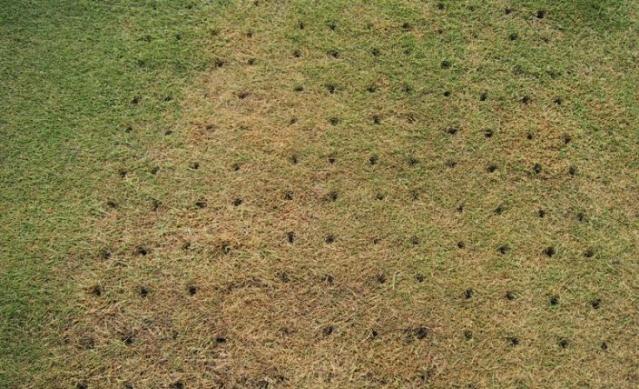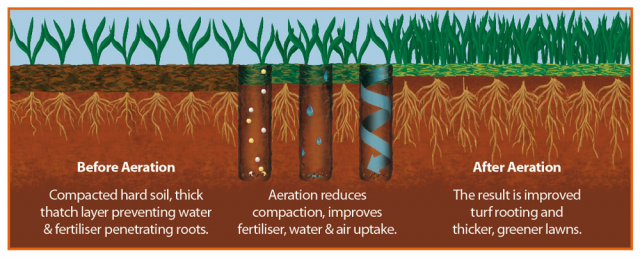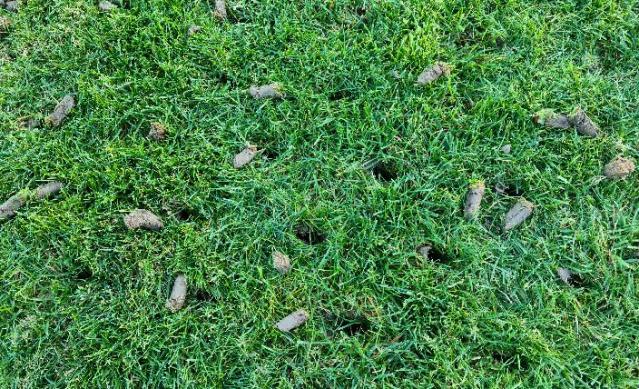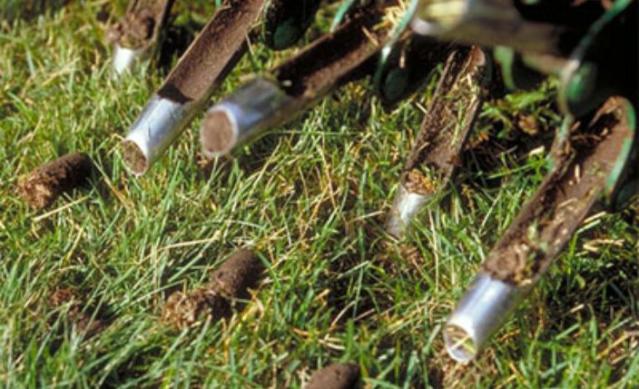Lawn Aeration
There are a number of processes that can be used to improve the health of a lawn. Some focus on the lawn plant itself, like mowing and scarifying. Others focus on the soil nutrients and structure. Without a nutrient rich well-structured soil it is impossible to grow a healthy lawn.
What is Lawn aeration?
Aeration is a process whereby small holes are made in the soil to allow the air, water and nutrients to penetrate the soil more easily. The process also makes the absorption of the air, water and nutrients easier for the grass roots by breaking up the dense soil. In addition the old carbon rich soil which is condensed becomes lighter thereby releasing oxygen which is vital for grass growth.
Aeration can be done by using a specialist machine which either makes use of hollow tines or solid spikes to puncture holes in the lawn, depending on the soil type. Generally speaking the deeper the aeration the better. If the lawn is small enough (or you have enough time and energy) this can be done by hand with a fork or spiked roller but won’t deliver the same results as the machine but is very hard work.
Why aerate your Lawn?
Over time a lawn builds up thatch (unless scarified regularly – see scarifying blog). This decayed matter builds up to form a thick matted organic layer. This layer can become a barrier for water, nutrients and air getting to the roots.
Add to this a dense, compact soil and the penetration of the vital nutrients, air and water become very difficult and consequently lawn health deteriorates.
When is the best time?
A lawn can theoretically be aerated at almost any time provided the area isn’t frozen, water-logged or too dry or hard making it very difficult to penetrate the surface. Which effectively means autumn or spring are your best chance at getting the ideal ground conditions. During these times growth is highest and any lawn damage or patches created recover quicker.
It is advisable to carry out lawn aeration at least once a year as well as a combination of scarification and over-seeding. With the soil preparation already done the new seed will have a much better chance of germinating successfully.
How to aerate your lawn correctly
The process of aerating a lawn is a fairly straight forward one. As mentioned previously the two types of aeration tools are a Hollow Tine Aerator or a Spike Aerator. The Hollow Tine removes a plug or core which is left on the surface of the lawn and is best for heavy clay soils. The Spike Aerator punches a hole into the soil and is better for sandy soils.
Before aerating or scarifying it is important to make sure that the lawn is mowed very short. Do this by lowering the mower after each pass and mowing in perpendicular directions.
Once the lawn is short, ensure the lawn is damp enough for the tines to penetrate (but not water-logged). Make sure there are no underground cables and locate any potential irrigation pipes before aerating.
It is worth assessing the thatch level before aerating, if the thatch is too thick perform a scarification first.
Aeration needs to be to a depth at least 50-70mm to be effective, (many light duty machines are not capable of achieving this depth) in this case it may be worth speaking to a lawn expert.
At this point it is important to note whether the lawn has any pests, like grass grub. If this is the case the lawn may be damaged in the process.
Once the aeration is complete it is advisable to consider a top dressing and over seeding to re-establish the lawn surface quicker and remove any imperfections. A starter fertilizer should be applied to assist the new seed in germinating quickly. The irrigation will also need to be adjusted to create conditions which will be conducive to the establishment of new lawn seed.
All of these processes can be carried out easily enough but it is advisable to get advice from a lawn expert before undertaking them on your own.




